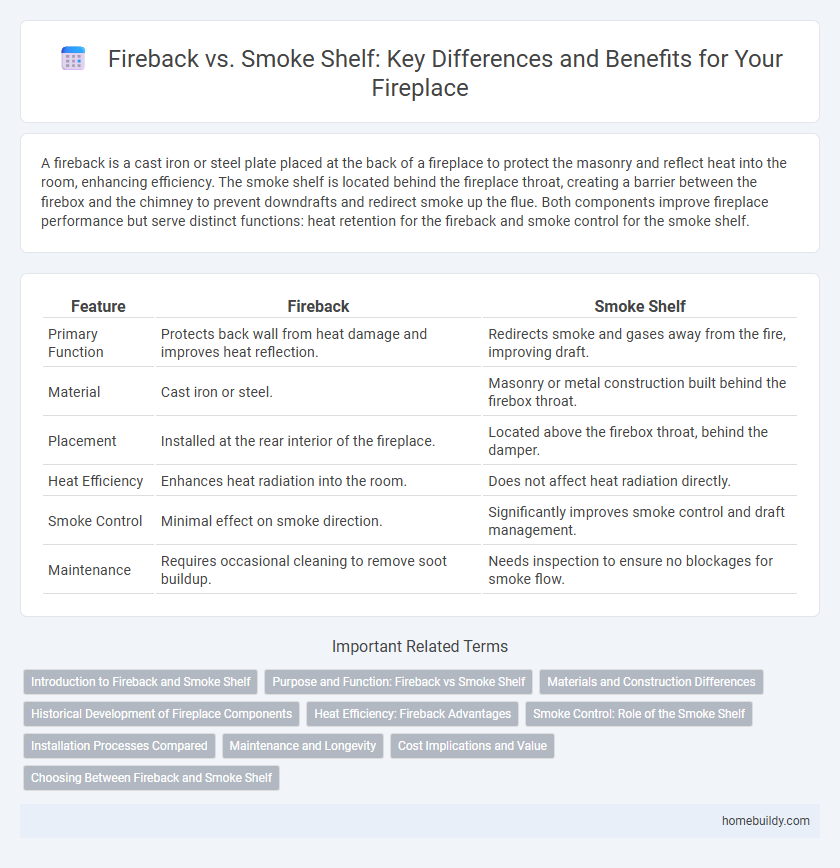A fireback is a cast iron or steel plate placed at the back of a fireplace to protect the masonry and reflect heat into the room, enhancing efficiency. The smoke shelf is located behind the fireplace throat, creating a barrier between the firebox and the chimney to prevent downdrafts and redirect smoke up the flue. Both components improve fireplace performance but serve distinct functions: heat retention for the fireback and smoke control for the smoke shelf.
Table of Comparison
| Feature | Fireback | Smoke Shelf |
|---|---|---|
| Primary Function | Protects back wall from heat damage and improves heat reflection. | Redirects smoke and gases away from the fire, improving draft. |
| Material | Cast iron or steel. | Masonry or metal construction built behind the firebox throat. |
| Placement | Installed at the rear interior of the fireplace. | Located above the firebox throat, behind the damper. |
| Heat Efficiency | Enhances heat radiation into the room. | Does not affect heat radiation directly. |
| Smoke Control | Minimal effect on smoke direction. | Significantly improves smoke control and draft management. |
| Maintenance | Requires occasional cleaning to remove soot buildup. | Needs inspection to ensure no blockages for smoke flow. |
Introduction to Fireback and Smoke Shelf
A fireback is a cast iron plate placed at the rear of a fireplace to protect the masonry and radiate heat into the room, enhancing overall warmth. A smoke shelf, located behind the damper, helps prevent downdrafts by redirecting smoke and gases up the chimney. Both components play crucial roles in fireplace efficiency, with the fireback focusing on heat retention and the smoke shelf on airflow management.
Purpose and Function: Fireback vs Smoke Shelf
A fireback is designed to protect the back wall of a fireplace from intense heat while reflecting warmth into the room, enhancing heating efficiency. In contrast, a smoke shelf is located behind the firebox damper and functions to trap downdrafts, preventing smoke from entering the room. Both components improve fireplace performance but serve distinct roles: heat reflection and wall protection for the fireback, and smoke control and air circulation for the smoke shelf.
Materials and Construction Differences
Firebacks are typically crafted from cast iron or steel, designed to absorb and radiate heat efficiently within a fireplace. Smoke shelves are built from masonry materials like brick or stone, serving as structural components that redirect smoke and gases up the chimney. The fireback's dense metal construction contrasts with the smoke shelf's masonry assembly, optimizing heat retention versus smoke flow control.
Historical Development of Fireplace Components
The fireback, originating in the 16th century, evolved as a cast iron or steel plate placed at the back of a fireplace to protect the masonry and reflect heat into the room. The smoke shelf, developed later during the 18th century, serves to improve draft control by preventing downdrafts and helping smoke flow smoothly up the chimney. Both components represent key advancements in fireplace design, enhancing efficiency and safety through their distinct functional roles.
Heat Efficiency: Fireback Advantages
Firebacks significantly enhance heat efficiency by reflecting radiant heat back into the room, unlike smoke shelves that primarily aid in airflow and prevent downdrafts. The thermal mass of a fireback absorbs and slowly radiates heat, increasing the overall warmth output from a fireplace. This results in more efficient energy use and a consistently warmer living space compared to relying solely on a smoke shelf.
Smoke Control: Role of the Smoke Shelf
The fireback protects the fireplace's rear wall from heat damage while the smoke shelf plays a critical role in managing smoke flow by creating a buffer zone that delays smoke from entering the room. The smoke shelf traps downdrafts and turbulence, ensuring smoke is directed up the chimney efficiently, reducing backflow. Effective smoke control hinges on the smoke shelf's design, which complements the fireback's heat resistance to enhance overall fireplace performance.
Installation Processes Compared
Firebacks require simple installation by positioning directly against the rear fireplace wall, often without the need for additional supports or brackets. Smoke shelves, however, involve a more complex installation as they must be securely integrated above the fireplace opening to control airflow and improve smoke drafting, often necessitating professional fitting. The straightforward setup of firebacks makes them a preferred choice for enhancing fireplace efficiency with minimal installation effort.
Maintenance and Longevity
Firebacks typically require less maintenance than smoke shelves because they protect the fireplace's back wall from heat damage and reduce soot buildup, extending the hearth's lifespan. Unlike smoke shelves, which can accumulate creosote and debris needing regular cleaning to prevent fire hazards, firebacks are made of durable cast iron or steel that withstands intense heat without warping or cracking. Proper installation of a fireback improves heat reflection and structural integrity, contributing to prolonged fireplace longevity and reduced upkeep costs.
Cost Implications and Value
Firebacks typically offer a cost-effective heating solution by radiating stored heat back into the room, often priced lower than the installation and construction costs associated with smoke shelves. While smoke shelves enhance chimney draft and improve combustion efficiency, their structural modifications can increase overall expenses due to labor and materials. Firebacks provide immediate value by combining aesthetic appeal with functional heat retention, making them a budget-friendly option for fireplace owners.
Choosing Between Fireback and Smoke Shelf
Selecting between a fireback and a smoke shelf depends on fireplace functionality and efficiency goals. A fireback, typically made of cast iron, enhances heat radiation and protects the firebox's back wall, while a smoke shelf improves airflow and smoke draft control by creating a barrier behind the chimney throat. Prioritizing heat distribution favors a fireback, whereas optimizing smoke management benefits from installing a smoke shelf.
Fireback vs Smoke Shelf Infographic

 homebuildy.com
homebuildy.com